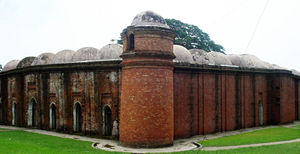Natore Rajbari
NATORE
How can i reach there: District: Natore > Natore Rajbari
The name of Rani Bhabani is that most nearly Related with what may be the most Impressive of the many palace in Bangladesh.
The Rajbari, or Zaminder palace continues to be one of the most familier places in Bangladesh for those for whom such hold attraction, and some of the Edwardian Neoclassical and Baroque pavilions serve as offices for government administration, which at least ensures a modicum of maintenance.
There are, in fact, to palaces, or Zaminderbari, in Natore, in Rajshahi Division of Bangladesh. The most ancient is, clearly, the Natore Rajbari: the other is Dighapatiya Palace, an Edwardian brick masterpiece, now known as Uttara Gono Bhaban, the official northern Presidential and Prime Ministerial residence.
This latter palace, for security reasons, is not easy to gain admission to, and it is forbidden to photograph; however, alittle way north, towards Bogra, stand the fine Pooja halls constructed for the earlier Raja, or Zaminder. These latter are certainly worth a visit.
The original Rajbari, the Natore Rajbari, sprawls across a wide area, and it is easy to miss some of the fine array of architectural monuments. It is, howver, in the area, the old palace ruins that are, in a very interesting site, the most compelling.
It is often claimed that Rani Bhabani was responsible for building this palace, but since it is clearly of Mughal origin, it seems likely that its origins were earlier. Born in 1716, to a Brahmin family living near Bogra, in 1731, not unusually, at the age of 15, she was married to Raja Ramakanta, the landholder under the Mughal dynasty of much of the Rajshahi area. It seems likely that the old palace was already his residence.
On his death in 1748, she became the landholder, also in the Mughal period known as the zaminder, although with somewhat less onerous duties than developed later.
Perhaps one of the most remarkable women in the history of the women of the area that was to become Bangladesh, her management of the vast landholdings she inherited made her famous. She not only maintained excellent relations with the Mughal Nawabs, the last independent one being the vanquished at the Battle of Plassey in 1757, but also with the developing regime of the East India Compant, who changed the role of Zaminder to one with far greater fiscal responsibility.
Until her death in 1795, she was famous for her extensive use of her influence and wealth on behalf of the communities that were her responsibility. A devout Hindu, although much of her work included the building of fine temples, both in the lands of Bangladesh, and in what is now West Bengal, in India, it was also focussed on the well being of Muslim and Hindu alike, sponsoring medical facilities, water storage tanks, roads and road houses for travellers.
The Rajbari that she knew in Natore was largely destroyed in the Great India Earthquake of 1897, but the brickwork and terracotta of those ruins describe a magnificent palace.
The zaminders of the late 19th Century replaced the buildings ruined by the impressive structures that remain. It takes the better part of a day to do justice to all that is to be seen there in the sprawling, tree studded acres, one of the few such places in Bangladesh to offer such ease of access and reasonably well maintained grounds.
District: Natore > Natore Rajbari















